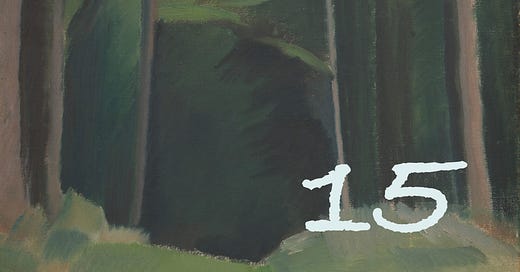The ... role of the artist ... is to illuminate that darkness, blaze roads through that vast forest ... to make the world a more human dwelling place. ~James Baldwin
Creativity Prompt #15: Writing Into & Through Our Senses | 30-Day Creativity Challenge
Unknown by Harald Giersing
Do you ever feel the weight of this reality: as writer-artists, we’re working with the world’s most tired and overused tool—words. If we hope to use words to illuminate anything at all, let along blaze a road through the vast forest to make the world a more human dwelling place, then we have to find ways to enliven language, wake it up, and make it capable of telling the truth again. That is what Writing in the Dark is all about.
And that arduous task of enlivening language starts with enlivening ourselves by honing of our quality of our own attention and—because we live in bodies—coming back to our senses. These are both crucial aspects of being a writer and growing as a writer, despite how tall these orders feel in our disconnected modern world.
But the effort is more than worthwhile. By sharpening our powers of attention and our awareness of our senses, we become more able to include powerful external details in our work, details that evoke a feeling from the reader. When strung together on purpose, precise exterior observations will often point to a deeper meaning that the reader can discover for herself without having it explained. Precise, exterior observations also create true metaphors, rather than constructed, overstretched ones. This, in the end, is what we really mean by the old adage, “show don’t tell.”
If you’ve only recently joined the 30-Day Creativity Challenge, don’t worry. You can find lots more information on paying attention and the senses here and here and here. Just catch up at your own pace, and no rush—this is literally a lifetime task. We can only practice; we will never arrive.
Meanwhile, even as we practice and practice on into eternity, we can also be playful with our senses. Allowing ourselves room to play and explore not only fosters a far more creative relationship with ourselves, the world, and our writing, but it also tends to produce interesting effects on the page and that—interesting work—is something I am constantly aspiring toward.
One way to play with the concept of sensory detail in our lives and on the page is to invite the presence of the extraordinary sensory condition called synesthesia. Here is an excerpt from the American Psychological Association that explains the phenomenon:
Guitar music doesn't just tickle Carol Crane's fancy--it also brushes softly against her ankles. When she hears violins, she also feels them on her face. Trumpets make themselves known on the back of her neck.
In addition to feeling the sounds of musical instruments on her body, Crane sees letters and numbers in brilliant hues. And for her, units of time each have their own shape: She sees the months of the year as the cars on a ferris wheel, with July at the top, December at the bottom.
Sean Day, PhD, tastes in technicolor.
"The taste of beef, such as a steak, produces a rich blue," says Day, a linguistics professor at National Central University in Taiwan. "Mango sherbet appears as a wall of lime green with thin wavy strips of cherry red. Steamed gingered squid produces a large glob of bright orange foam, about four feet away, directly in front of me."
Crane and Day share an extraordinary sensory condition called synesthesia.
The phenomenon--its name derives from the Greek, meaning "to perceive together"--comes in many varieties. Some synesthetes hear, smell, taste or feel pain in color. Others taste shapes, and still others perceive written digits, letters and words in color. Some, who possess what researchers call "conceptual synesthesia," see abstract concepts, such as units of time or mathematical operations, as shapes projected either internally or in the space around them. And many synesthetes experience more than one form of the condition.
The condition is not well known, in part because many synesthetes fear ridicule for their unusual ability. Often, people with synesthesia describe having been driven to silence after being derided in childhood for describing sensory connections that they had not realized were atypical.
How sad that people with this almost magical extrasensory perception experience ridicule and silencing. Here in this week’s prompt, we celebrate this permeable boundary between the senses with a structured, two-step writing prompt that invites you into and guides you thoughtfully through a process of marrying your senses to each other through language in a manner that just might open up a whole new way of experiencing the world, and the page.





